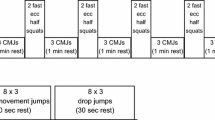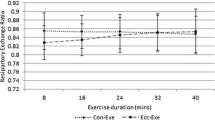Summary
An experimental group of 15 middle-aged males participated in a 5-month endurance running program. Significant improvement was observed in maximal oxygen uptake, maximal ventilation, maximal oxygen pulse, and 2-mile run time.
A highly trained group of 10 middle-aged males who had been running 2 years or more were compared with the experimental group. The highly trained group was superior in maximal oxygen uptake, maximal ventilation, maximal oxygen pulse, and the 2-mile run time both before and after the 5-month training program of the experimental group. Each of the measures used in this study shows a characteristic age decline after maturity and it appears that these trends are reversible with training.
Similar content being viewed by others
Bibliography
Andersen, K. L., andL. Hermansen: Aerobic work capacity in middle-aged men. J. appl. Physiol.20, 432–436 (1965).
Brozek, J., andA. Henschel: Techniques for Measuring Body Composition, p. 128. Washington, D. C.: National Academy of Science 1961.
Consolazio, C. F., R. E. Johnson, andL. J. Pecora: Physiological Measurements of Metabolic Functions in Man, p. 1–59. New York: Mc Graw Hill 1963.
Cureton, T. K., andE. E. Phillips: Physical fitness changes in middle-aged men attributable to equal eight-week periods of training, nontraining, and re-training. J. Sport Med. Phys. Fitness.4, 1–7 (1964).
Edwards, A. L.: Experimental Design in Psychological Research, p. 154. Chicago: Holt, Rinehart and Winston 1965.
Naughton, J., andB. Balke: Physical working capacity in medical personnel and the response of serum cholesterol to acute exercise and training. Amer. J. med. Sci.247, 286–292 (1964).
-, and F.Nagle: Peak oxygen intake during physical fitness programs for middle-aged men. J. Amer. med. Ass. (1964).
Oscai, L. B., andB. T. Williams: Effect of exercise on overweight middle-aged males. J. Amer. Geriat. Soc.16, 794–797 (1968).
Pascale, L. R., M. I. Grossmann, H. S. Sloane, andT. Frankel: Correlations between thickness of skinfolds and body density in 88 soldiers. Hum. Biol.28, 165–176 (1956).
Robinson, S.: Experimental studies of physical fitness in relation to age. Arbeitsphysiologie.10, 251–323 (1938).
Valentin, V., H. Venrath, H. V. Mallinkrodt u.M. Guraker: Die maximale Sauerstoffaufnahme in den verschiedenen Alterklassen. Eine praktisch wichtige Herz-Kreislauf-Funktionsprüfung im Vita maxima-Bereich. Z. Alternsforsch.9, 291–309 (1955).
Author information
Authors and Affiliations
Additional information
Submitted in partial fulfillment of the requirements for the Ph. D. degree in Physical Education at the University of Illinois under Dr.Th. K. Cureton.
Rights and permissions
About this article
Cite this article
Ribisl, P.M. Effects of training upon the maximal oxygen uptake of middle-aged men. Int. Z. Angew. Physiol. Einschl. Arbeitsphysiol. 27, 154–160 (1969). https://doi.org/10.1007/BF00697929
Received:
Issue Date:
DOI: https://doi.org/10.1007/BF00697929




